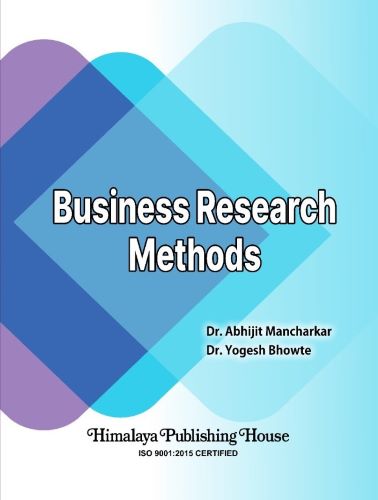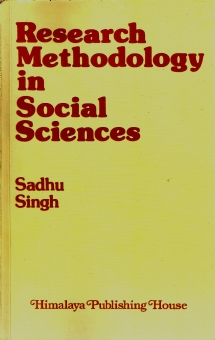The purpose of research is to equip business managers and entrepreneurs with new knowledge which in turn forms the basis for strategic decisions. Research is a very powerful tool to solve the most critical problems faced by the business organizations. The knowledge generated by research guides managers and entrepreneurs in designing creative strategies and plans. Hence, the management professionals should prudently use research for success of business organizations.
It gives us immense pleasure to present the book titled ‘Business Research Methods’ for MBA Semester – II as per the MBA Revised Curriculum 2024 (Aligned with NEP) of Savitribai Phule Pune University. The syllabus of the course is comprehensively covered in this book. The concepts and practical applications are explained thoroughly. Throughout the book a methodical approach is used for explanation coupled with apt examples. A question bank as per Bloom’s taxonomy is given for practice after every unit. A simple language and clarity of concepts are the highlights of this book.
Contents –
1. Foundations of Research
1.1 Concept and Definitions of Research
1.1.1 Concept of Research
1.1.2 Definitions of Research
1.2 Need of Business Research
1.3 Characteristics of Scientific Research Method
1.4 Typical Research Applications in Business and Management
1.5 Process of Business Research
1.6 Formulation of Problems/Questions in Research
1.6.1 Management Question/Problem
1.6.2 Research Question/Problem
1.6.3 Investigation Question/Problem
1.7 Role of Review of Literature in Research
1.8 Research Proposal
1.8.1 Types of Research Proposals
1.8.2 Elements of Research Proposal
1.8.3 Evaluating a Research Proposal
1.9 Values and Ethics in Research
1.10 Question Bank for Practice
2. Research Design
2.1 Research Design
2.1.1 Concept of Research Design
2.1.2 Features of a Robust Research Design
2.1.3 Types of Research Designs
2.2 Exploratory Research Design
2.2.1 Concept of Exploratory Research Design
2.2.2 Choice of Exploratory Research Design
2.2.3 Advantages (Pros) of Exploratory Design
2.2.4 Disadvantages (Cons) of Exploratory Design
2.2.5 Qualitative Techniques used for Exploratory Research
2.3 Descriptive Research Design
2.3.1 Concept of Descriptive Research Design
2.3.2 Choice of Descriptive Research Design
2.3.3 Advantages (Pros) of Descriptive Design
2.3.4 Disadvantages (Cons) of Descriptive Design
2.3.5 Types of Descriptive Research
2.4 Experimental Research Design
2.4.1 Concept of Experimental Research Design
2.4.2 Choice of Experimental Research Design
2.4.3 Concept of Cause and Effect
2.4.4 Difference between Correlation and Causation
2.4.5 Important Concepts in Experimental Research
2.4.6 Advantages (Pros) of Experimental Design
2.4.7 Disadvantages (Cons) of Experimental Design
2.4.8 Quasi-Experimental Design
2.5 Case Study Design
2.6 Research Approaches
2.6.1 Quantitative Approach
2.6.2 Qualitative Approach
2.6.3 Comparison of Qualitative Approach and Quantitative Approach
2.7 Hypothesis
2.7.1 Meaning of Hypothesis
2.7.2 Qualities of a Good Hypothesis
2.7.3 Research Hypothesis and Statistical Hypothesis
2.7.4 Framing Null and Alternate Hypothesis
2.7.5 Logic and Importance of Hypothesis Testing
2.8 Contents of Research Design
2.8.1 Contents of Exploratory and Descriptive Research Design
2.8.2 Contents of Experimental Research Design
2.9 Question Bank for Practice
3. Data and Measurement
3.1 Data
3.1.1 Meaning of Data
3.1.2 Need for Data
3.1.3 Types of Data
3.2 Secondary Data
3.2.1 Definition
3.2.2 Characteristics
3.2.3 Sources
3.2.4 Advantages
3.2.5 Disadvantages
3.2.6 Quality of Secondary Data
3.3 Primary Data
3.3.1 Definition
3.3.2 Characteristics
3.3.3 Sources
3.3.4 Advantages
3.3.5 Disadvantages
3.4 Measurement
3.4.1 Concept
3.4.2 What is Measured?
3.4.3 Problems in Measurement
3.4.4 Levels of Measurement
3.5 Attitude Scaling Techniques
3.5.1 Concept of Scale
3.5.2 Rating Scales
3.5.3 Ranking Scales
3.6 Data Collection Methods: Survey Method
3.6.1 Personal Interview
3.6.2 Telephonic Interview
3.6.3 Self-Administered Survey
3.6.4 Electronic Survey (e-survey)
3.7 Data Collection Instruments: Questionnaire
3.8 Question Bank for Practice
4. Sampling
4.1 Basic Concepts in Sampling
4.1.1 Population/Universe
4.1.2 Sample
4.1.3 Census vs. Sampling
4.1.4 Characteristics of a Good Sample Design
4.2 Sampling Process/Steps in Sample Design/Process of Designing Sampling Plan
4.2.1 Define Target Population
4.2.2 Get Sampling Frame/Source List
4.2.3 Decide Census or Sampling
4.2.4 Decide Sampling Method/Technique/Procedure
4.2.5 Decide Sample Size
4.2.6 Draw Sample
4.3 Probability Sampling Methods
4.3.1 Simple Random Sampling Method
4.3.2 Stratified Sampling Method
4.3.3 Cluster Sampling Method
4.3.4 Area Sampling Method
4.3.5 Systematic Sampling Method
4.3.6 Multistage Sampling Method
4.4 Non-Probability Sampling Methods
4.4.1 Convenience Sampling Method
4.4.2 Purposive Sampling Method
4.4.3 Judgement Sampling Method
4.4.4 Quota Sampling Method
4.4.5 Snowball Sampling Method
4.5 Errors in Research
4.5.1 Sampling Error
4.5.2 Non-Sampling Errors
4.5.3 Methods to Reduce Errors in Research
4.6 Contents of Sampling Design/Plan
4.7 Question Bank for Practice
5. Data Analysis and Report Writing
5.1 Data Analysis and Interpretation
5.2 Data Preparation
5.2.1 Editing
5.2.2 Coding
5.2.3 Data Entry/Transcribing
5.2.4 Data Cleaning
5.3 Tabular and Graphical Representation of Data
5.3.1 Tabular Representation of Data
5.3.2 Graphical Representation of Data
5.4 Descriptive Analysis and Interpretation
5.4.1 Univariate Analysis
5.4.2 Bivariate Analysis
5.4.3 Multivariate Analysis
5.5 Inferential Analysis: Tests of Significance
5.5.1 Parametric Tests
5.5.2 Non-Parametric Tests
5.5.3 Hypothesis Testing: Interpretation Problems based on Data Driven Perspective
5.6 Research Report
5.7 Question Bank for Practice







